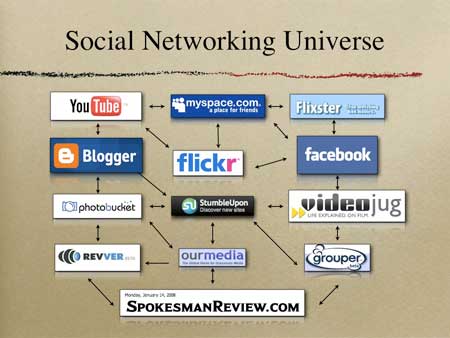As my restless vacation continues into its second week, my mind reels with the prospects of an uncertain future. Like most newspapers across the country, steep revenue declines are disrupting any semblance of job security for print journalists. Media companies seem to be in a race to tear down their brick and mortar operations and reinvent themselves as digitally delivered platforms. In my own newsroom, a large radio production studio has been built where hourly news broadcasts are being produced.
In September, our new modern website will debut. With it will come cutting edge tools for social media integration, an enhanced navigation that will break paradigms and a clean, airy, low-contrast design that will forever free us from our stodgy past.
The Spokesman-Review, like most newspapers, has begun to fully embrace change. The 700-pound gorilla on everyone’s back is the, “is it too late?” question.
Under the duress of a deepening recession, media companies are making rapid changes to their organizations. We are now in a war of transition, where the bodies of thousands of laid-off journalists line the road leading to their former newspaper’s digital future. The diminishing relevance of the print product, for some, relegated to the status of niche; weigh heavily on the minds of many.
At a Spokesman-Review newsroom staff meeting last week, my editor, Steve Smith, laid out the sobering facts of how far and fast our decline has been. There were lots of charts with graph arrows pointing toward the carpet. Smith’s voice, tinged with emotion, filtered through the room with a heavy cast of “this is it folks.” “I want to save everyone’s job, including my own,” said Smith.
He and everyone in the room understood that his statement comes with no guarantees. The truth is there will soon be less of us to carry on the battle. Unless. Unless we quickly build out our digital platforms in a way that they can begin to generate a potential for steady revenue growth.
For this to work, Smith says a lot of mindsets have to change. The focus on the print product will be diminished. Instead a web-centric approach will be strengthened. A new newsroom structure is being conceived, one that is vastly different from the one in place now.
For all of these changes to be successful, I believe innovation, a catch phrase of the new millennium, will have to become the new DNA that drives the reimagined newsroom. Creative ideas will need to be rewarded. Grassroots innovation is where, I believe, that one brilliant idea that saves us all will emerge.
For many in journalism, the future doesn’t seem too bright. It is hard to be innovative without having job security. Many of us wonder what our futures would be like if we cannot be storytellers anymore. To be relegated to some job as a PR flack or a wedding photographer dealing with the bridezillas of the world would be sad indeed.
Instead, how about we all stand and fight for the profession we’re passionate about? Our jobs are already hanging by a thread, so what have we got to lose? This is a unique time to be in journalism. Yes, it is changing, but now we all have a chance to shape what those changes will be. The focus now needs to be on the future, not on the past. Accept the changes that have already occurred and then find a better way to implement the changes the future holds. The failed strategies of the past need to fall away.
Yes, it is time to stand and fight. Fight for the journalism values ingrained to our core. Stand and fight for our role as watchdogs and muckrakers. Stand and fight to hold those in power accountable. Stand and fight against the tide of backlash–because new thinking is sometimes perceived as a threat to our comfort zone. The reality is there are no comfort zones left. From now on, it is survival of the fittest. Game on.



